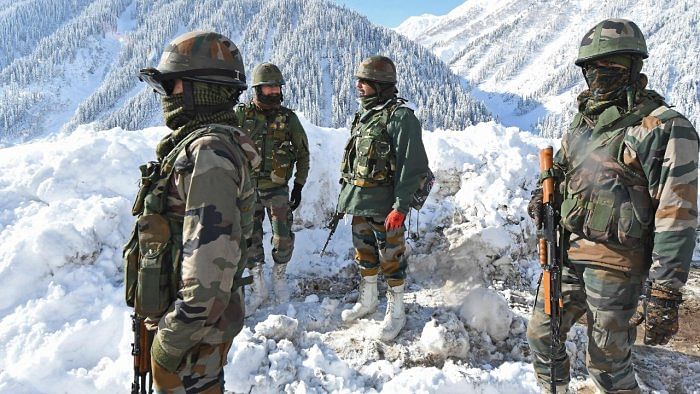
The morning of January 1, 2022, was a bit different for Indian and Chinese soldiers deployed in eastern Ladakh. They had by then already spent more than 20 months engaged in an -to-eyeball stand-off all along the Line of Actual Control (LAC) – the de facto boundary between the two nations. But belligerence gave way to bonhomie at multiple face-off points that day as they exchanged greetings and sweets to ring in the New Year in the icy heights of the Himalayas, once again raising hope for an early end to the stand-off.
But, five months into 2022, the hope has now faded. The stand-off, which started in April-May 2020, has entered its third year, and the negotiations to end it remained stalled. Each side still has nearly 50000-60000 troops deployed all along the disputed boundary between the two nations in the western sector.
Read | India’s China challenge
It's no wonder the new chief of the Indian Army, Gen Manoj Pande, recently told journalists that India’s stand-off with China along its northern border was his “utmost concern”.
It was in April 2020 when the headquarters of the Indian Army’s 14 corps at Karu near Leh started receiving reports from the forward posts about the Chinese PLA’s build-up along the LAC. The PLA moved to hinder the traditional patrolling pattern of the Indian Army troops in the Galwan Valley. A skirmish on the northern bank of Pangong Tso on May 5, 2020 left some soldiers of both sides injured. China amassed a large number of troops along the LAC, flouting its 1993 and 1996 agreements with India. The PLA made several attempts to transgress into the territory of India. The Indian Army responded with counter deployment – resulting in the stand-off in multiple locations all along the LAC. It reached a flashpoint with the clash in Galwan Valley on June 15, 2020, when the Indian Army lost 20 of its soldiers. The PLA later revealed that it had also lost four soldiers.
The negotiations to resolve the stand-off went on at multiple levels over the past two years – between External Affairs Minister S Jaishankar and Chinese Foreign Minister Wang Yi, between diplomats of the two sides and between the commanders of the Indian Army and the Chinese PLA, who so far held 15 rounds of negotiations since the stand-off started.
The first breakthrough in negotiations came on June 30, 2020 – a fortnight after the clash in Galwan Valley. The withdrawal of the Indian Army troops from the scene of the clash to reciprocate to the pull-back by the Chinese PLA as well as the moratorium on patrolling resulted in the creation of a three-kilometre-long (about 1.5 kilometres on both sides) “buffer zone”.
The PLA in April 2020 built bunkers and observation posts and deployed additional troops near Finger 4 on the northern bank of Pangong Tso – thus denying access to the Indian Army to its earlier patrolling limit at Finger 8, which, according to New Delhi, marked the LAC. The Indian Army carried out an overnight operation on August 29-30, 2020, occupying several dominating heights on the southern bank of Pangong Tso overlooking the key positions of the Chinese PLA. This gave the Indian Army a strategic advantage over the Chinese Army and later helped it in negotiating a deal for mutual withdrawal of troops by the two sides from both banks of the lake in February 2021. The deal, however, created an eight-kilometer-long “buffer zone” between Finger 3 and Finger 8 on India’s side of the LAC with China (on Pangong Tso northern bank), with moratorium on patrolling by both sides. India of course also had to give up its strategic advantage over China on the southern bank of the lake.
This was followed by a deal for withdrawal of front-line troops by both sides from Gogra Post in August 2021 – again after creating a “buffer zone”, similar to the ones in Galwan Valley and on the banks of Pangong Tso.
Though a deal for disengagement of troops from Hot Springs area was perceived to be the next “lowest-hanging fruit” for negotiators of the two sides to pluck, they couldn’t do so in the past nine months, because China stuck to its demand that while it would pull-back its troops just about one or two kilometres, India would have to move back its soldiers from the frontline position by several kilometres.
The two sides are yet to start a discussion on several other face-off points, including Depsang Plains, located closer to the strategically important Daulat Beg Oldie airstrip of India and between Siachen Glacier and Aksai Chin controlled by China. The Chinese PLA has been denying the Indian Army access to Patrol Points 10 to 13 in Depsang Plains beyond the Y Junction. It is only after completing the disengagement of front-line soldiers from all the face-off points along the LAC, the two sides can start the discussion on de-escalation or withdrawal of troops from the “depth areas” on the respective sides and eventually move towards restarting the talks between the Special Representatives of the two governments to resolve the boundary disputes, a process which was going on since 2003. All these now appear to be distant though.
Jaishankar as recently as on March 25 told Wang in New Delhi that the relations between the two nations could be ‘normal’ only when China would withdraw the unusually large number of soldiers it had deployed along its LAC with India.
Meanwhile, in the wake of the geopolitical churning triggered by the Russia-Ukraine conflict, the United States and other western nations of late warned about the possibility of China stepping up its belligerence not only against India but also against its maritime neighbours in the Indo-Pacific region.
